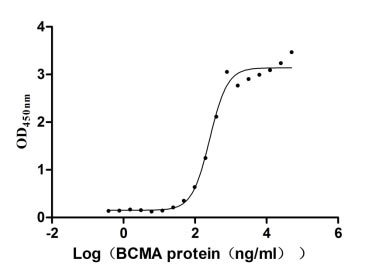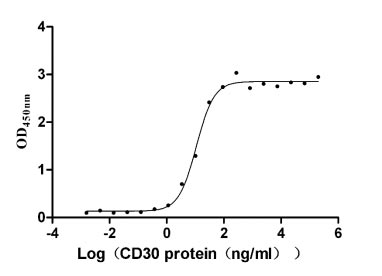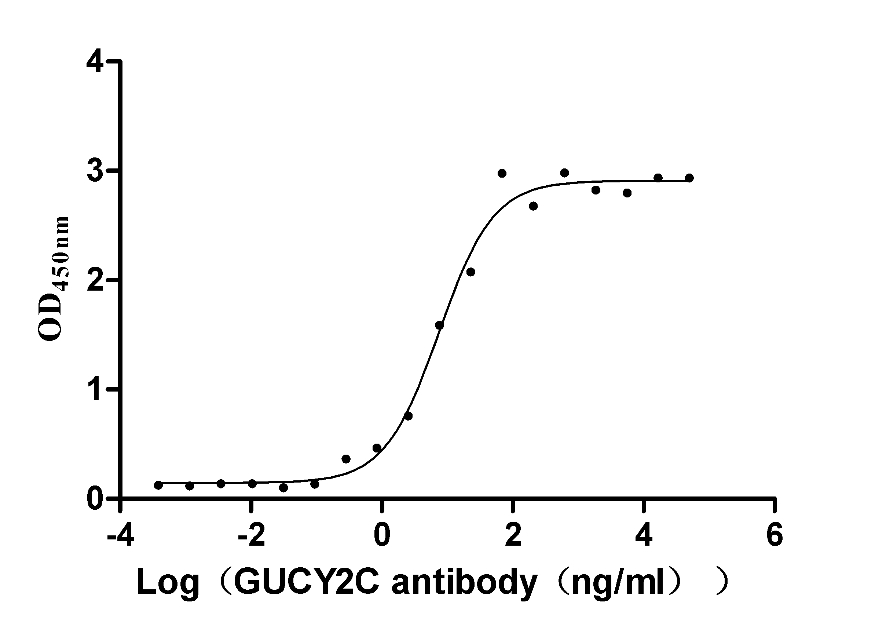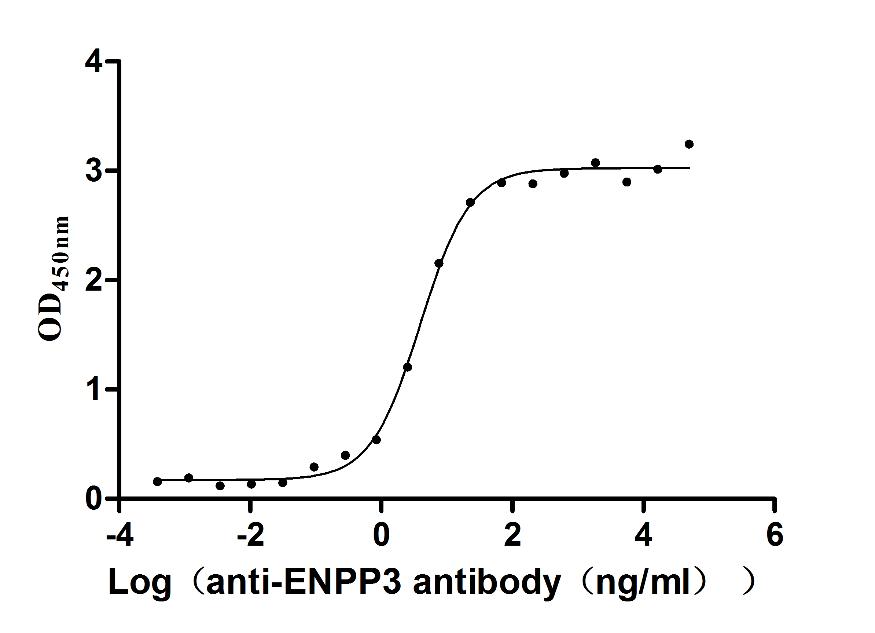Recombinant Human Paired box protein Pax-9 (PAX9)
-
中文名称:人PAX9重组蛋白
-
货号:CSB-YP017495HU
-
规格:
-
来源:Yeast
-
其他:
-
中文名称:人PAX9重组蛋白
-
货号:CSB-EP017495HU
-
规格:
-
来源:E.coli
-
其他:
-
中文名称:人PAX9重组蛋白
-
货号:CSB-EP017495HU-B
-
规格:
-
来源:E.coli
-
共轭:Avi-tag Biotinylated
E. coli biotin ligase (BirA) is highly specific in covalently attaching biotin to the 15 amino acid AviTag peptide. This recombinant protein was biotinylated in vivo by AviTag-BirA technology, which method is BriA catalyzes amide linkage between the biotin and the specific lysine of the AviTag.
-
其他:
-
中文名称:人PAX9重组蛋白
-
货号:CSB-BP017495HU
-
规格:
-
来源:Baculovirus
-
其他:
-
中文名称:人PAX9重组蛋白
-
货号:CSB-MP017495HU
-
规格:
-
来源:Mammalian cell
-
其他:
产品详情
-
纯度:>85% (SDS-PAGE)
-
基因名:PAX9
-
Uniprot No.:
-
别名:Paired box 9; Paired box gene 9; Paired box homeotic gene 9; Paired box protein 9; Paired box protein Pax 9; Paired box protein Pax-9; Paired box protein Pax9; Paired domain gene 9; PAX 9; PAX9; PAX9_HUMAN; STHAG3
-
种属:Homo sapiens (Human)
-
蛋白长度:Full length protein
-
表达区域:1-341
-
氨基酸序列MEPAFGEVNQ LGGVFVNGRP LPNAIRLRIV ELAQLGIRPC DISRQLRVSH GCVSKILARY NETGSILPGA IGGSKPRVTT PTVVKHIRTY KQRDPGIFAW EIRDRLLADG VCDKYNVPSV SSISRILRNK IGNLAQQGHY DSYKQHQPTP QPALPYNHIY SYPSPITAAA AKVPTPPGVP AIPGSVAMPR TWPSSHSVTD ILGIRSITDQ VSDSSPYHSP KVEEWSSLGR NNFPAAAPHA VNGLEKGALE QEAKYGQAPN GLPAVGSFVS ASSMAPYPTP AQVSPYMTYS AAPSGYVAGH GWQHAGGTSL SPHNCDIPAS LAFKGMQAAR EGSHSVTASA L
-
蛋白标签:Tag type will be determined during the manufacturing process.
The tag type will be determined during production process. If you have specified tag type, please tell us and we will develop the specified tag preferentially. -
产品提供形式:Lyophilized powder
Note: We will preferentially ship the format that we have in stock, however, if you have any special requirement for the format, please remark your requirement when placing the order, we will prepare according to your demand. -
复溶:We recommend that this vial be briefly centrifuged prior to opening to bring the contents to the bottom. Please reconstitute protein in deionized sterile water to a concentration of 0.1-1.0 mg/mL.We recommend to add 5-50% of glycerol (final concentration) and aliquot for long-term storage at -20℃/-80℃. Our default final concentration of glycerol is 50%. Customers could use it as reference.
-
储存条件:Store at -20°C/-80°C upon receipt, aliquoting is necessary for mutiple use. Avoid repeated freeze-thaw cycles.
-
保质期:The shelf life is related to many factors, storage state, buffer ingredients, storage temperature and the stability of the protein itself.
Generally, the shelf life of liquid form is 6 months at -20°C/-80°C. The shelf life of lyophilized form is 12 months at -20°C/-80°C. -
货期:Delivery time may differ from different purchasing way or location, please kindly consult your local distributors for specific delivery time.Note: All of our proteins are default shipped with normal blue ice packs, if you request to ship with dry ice, please communicate with us in advance and extra fees will be charged.
-
注意事项:Repeated freezing and thawing is not recommended. Store working aliquots at 4°C for up to one week.
-
Datasheet :Please contact us to get it.
相关产品
靶点详情
-
功能:Transcription factor required for normal development of thymus, parathyroid glands, ultimobranchial bodies, teeth, skeletal elements of skull and larynx as well as distal limbs.
-
基因功能参考文献:
- focus on associations between mutations in PAX9 and occurrence of congenitally missing teeth and/or other variations in human teeth (review). PMID: 28155232
- low expression levels of PAX9 were significantly associated with poor survival in ESCC patients following surgery. PAX9 may be an independent prognostic factor for ESCC patient survival. PMID: 28560390
- Study highlights PAX9 as a novel marker of prognostication in chronic lymphocytic leukemia as its expression was significantly associated with high risk of treatment initiation, shorter time to first treatment and overall survival. PMID: 28572861
- in vitro functional analysis creating PAX9 minigene construct did apparently show no effect on the splice-site migration. It is therefore proposed that haploinsufficiency of PAX9 is the causal factor for tooth agenesis in this family. PMID: 28847717
- Statistically significant relations were found between detected 22 variations in PAX9 gene and tooth size and were detected in which 18 of them are novel. PMID: 28040065
- The AG and GG genotypes at rs2073244 and the CC genotype at rs4904210 may strengthen the association between cytomegalovirus infection and low birth weight. PMID: 26333297
- results demonstrate a new initiation codon mutation in the PAX9 gene; this mutation probably caused the oligodontia in the investigated Chinese family through haplo-insufficiency PMID: 26571067
- previously unknown heterozygous g.9527G>T mutation in the PAX9 gene in monozygotic twins with oligodontia & 3 additional affected family members. mutation is located in intron 2, splice site between exon 2 and intron 2. PMID: 25683653
- A direct effect of rs12882923 and rs12883049 polymorphisms on the dental agenesis was excluded. PMID: 26707046
- analysis provided evidence for gene-gene interaction between FGF3 (rs4980700) and PAX9 (rs2073242), increasing risk for isolated oral clefts (p = 0.0003). FGF3 is associated with oral clefts and may interact with PAX9. PMID: 24697712
- The meta-analysis results revealed 4 genetic sites of the PAX9 gene involved in hypodontia cases. PMID: 25501211
- Probably other genes can determine phenotypical patterns of dental agenesis in the families studied, different than the ones described in the mutations of PAX9 PMID: 24316698
- Polymorphisms in the promoter region of PAX9 gene may have an influence on the transcriptional factors and activity of this gene. PMID: 24160254
- Identification of novel mutations in the paired domain of PAX9 in two unrelated Japanese patients with sporadic non-syndromic oligodontia. PMID: 24436340
- Family study; 11 yr old male proband + relatives confirming a frameshift mutation in a family with autosomal-dominant hypodontia. PMID: 24028587
- The genotype/phenotype correlation in congenital anodontia cannot be verified, as there was only one pedigree analyzed PMID: 23857653
- mutations in this gene have been associated with non-syndromic tooth agenesis PMID: 22747565
- A family with tooth agenesis had a homozygous point mutation at the 718 position (G to C) in exon 3 (a nonpaired domain) of PAX9. PMID: 19641755
- A spontaneous novel mutation in COL1A2 (c.1171G>A; p.Gly391Ser) causing only dentin defects and a novel mutation in PAX9 (c.43T>A; p.Phe15Ile) causing hypodontia were identified and correlated with the phenotypic presentations in the family. PMID: 23227268
- Common variants in PAX9 contributed to morphological variation in permanent teeth in humans. PMID: 22810112
- The SNP rs7142363 in the PAX9 gene contributes to nonsyndromic cleft lip/palate. PMID: 22976623
- Two novel missense mutations in Chinese families causing oligodontia: Leu27Pro (L27P) and Ile29Thr (I29T) in the paired-domain of PAX9. Analysis of homologous PAX proteins indicated that these two substitutions may affect the function of the PAX9 protein. PMID: 22277187
- reduced transcriptional activity of the novel nonsense codon mutated PAX9 protein suggested that the severe phenotype may result from haploinsufficiency of PAX9. PMID: 22058014
- findings may imply that the PAX9 A240P mutation is a risk factor for oligodontia in the Chinese population. PMID: 21530942
- Pax9hapl a may have a protective effect against sporadic oligodontia PMID: 22185249
- A novel g.-1258G>A mutation in a conserved putative regulatory element of PAX9 is associated with autosomal dominant molar hypodontia. PMID: 21443745
- Common variants located out of the DNA binding domain of the PAX9 gene can be related to tooth agenesis. PMID: 21111400
- a set of variants in PAX9 and 101 other genes related with dentition can define at least some dental morphological differences between Sub-Saharan Africans and non-Africans, probably associated with adaptations after the modern human exodus from Africa. PMID: 21298044
- This study describes how the same mutation is responsible for a form of dental agenesis--less severe in the number of missing teeth--leading to hypodontia instead of oligodontia. Mutations of the same gene cause different phenotypes. PMID: 21434731
- 322insG mutation causes insufficient function of PAX9 protein and haploinsufficiency as a genetic model of familial non-syndromic oligodontia PMID: 21098475
- A polymorphism in the PAX9 gene was detected in individuals with maxillary lateral incisor agenesis, the frequency of which was not, however, statistically different from that in the control population. PMID: 20660504
- investigation of transcriptional activity of specific regions of promoter region of PAX9 gene: sequences present between -1106 and +92 are important for expression of PAX9 PMID: 20941745
- mutations of the PAX9 gene may represent polymorphism associated with sporadic oligodontia PMID: 20618716
- The findings in this patient illustrate the role of the PAX9 gene in tooth development and provide the first example of a de novo deletion of 14q13.3 manifesting primarily with oligodontia. PMID: 20485064
- Families with a posterior pattern of tooth agenesis showed changes in the PAX9 gene. PMID: 19816326
- Smaller tooth crown dimensions recorded in the affected family members show that the effect of the PAX9 mutation is seen not only in the congenitally missing teeth but also in smaller crown size throughout the dentition. PMID: 18653171
- haploinsufficiency is associated with autosomal dominant hypodontia PMID: 11941488
- Report a case of erroneous direct sequencing, in which a single nucleotide polymorphism (SNP) in the human PAX9 gene was mistyped due to allele-dependent PCR amplification. PMID: 12107448
- BF-1 and PAX9 interact with PLU-1 via a novel conserved sequence motif (Ala-X-Ala-Ala-X-Val-Pro-X4-Val-Pro-X8-Pro, termed the VP motif) PMID: 12657635
- G151A transition might be responsible for sporadic form of tooth agenesis PMID: 12786960
- There was a significant reduction in PAX9 expression in fetuses with the Jarcho-Levin syndrome. PMID: 12833407
- PAX9 has a role in tooth development in humans PMID: 14607846
- A missense mutation in the paired domain of PAX9 causes non-syndromic anodontia. PMID: 14689302
- mutation of the initiation codon causes oligodontia PMID: 15615874
- The functional defects in DNA binding of mutant 109(InsG) PAX9 and 139(C--> T) PAX9, as well as loss-of-function of PAX9 most likely result in its haploinsufficiency during the patterning of dentition and the subsequent loss of posterior teeth. PMID: 16086281
- Sequencing of PAX9 gene revealed a novel frameshift mutation and a novel missense mutation in Chinese patients with oligodontia. PMID: 16191360
- Mutations in PAX9 constitute a causative factor in nonsyndromic oligodontia. PMID: 16333316
- Ile87Phe protein shows that both wild-type and mutant proteins are synthesized in mammalian cells and that the mutation does not alter the nuclear localization of the mutant protein in a family with molar oligodontia. PMID: 16479262
- calcitonin gene expression could be directly activated by Nkx2.1, whereas Pax9 is not involved in transcription from the 2kbp calcitonin promoter PMID: 17412341
- A novel nonsense mutation in PAX9 is associated with marked variability in number of missing teeth. PMID: 17697174
收起更多
-
相关疾病:Tooth agenesis, selective, 3 (STHAG3)
-
亚细胞定位:Nucleus.
-
数据库链接:
HGNC: 8623
OMIM: 167416
KEGG: hsa:5083
STRING: 9606.ENSP00000355245
UniGene: Hs.132576







f4-AC1.jpg)












